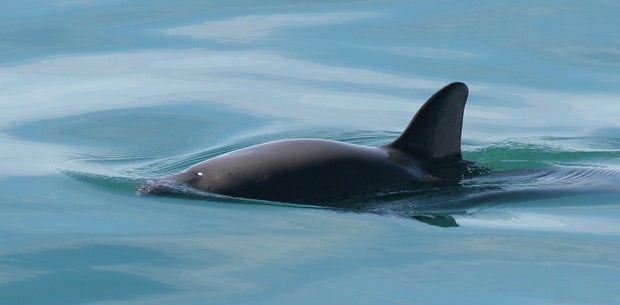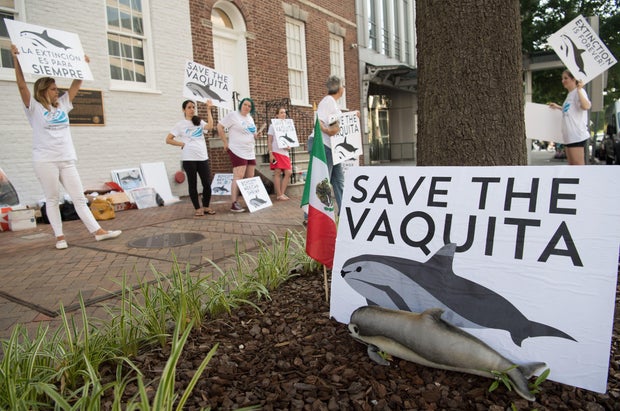Mexico’s number critically endangered vaquita porpoises spotted in the Gulf of California have dropped to between 6 and 8 this year, researchers said Tuesday, although it’s possible some of the creatures have moved elsewhere in the Gulf, the only place in the world where they live.
Vaquitas are the smallest porpoise in the world and the most endangered marine mammal on the planet.
Last year, experts on a sighting expedition estimated they saw between 10 and 13 tiny, shy and elusive porpoises during nearly two weeks of sailing in the Gulf, also known as the Sea of Cortez.
But this year, the conservation group Sea Shepherd said a similar expedition carried out over three weeks in May spotted only about half a dozen, although the search was not as extensive as last year’s. Most worryingly, no baby vaquitas have been seen this year.
“Unlike in 2023, no newborn calves were seen, but one healthy calf was seen,” Sea Shepherd said in a statement.
However, about half of last year’s sightings occurred outside and west of the vaquita’s exclusive protection zone, a heavily patrolled area in the Gulf where all fishing is prohibited, although some still occur illegally.
Paula Olson/NOAA
Experts don’t know exactly why vaquitas might like the area outside the protected zone, but this year’s expedition focused on areas within the zone.
Because they are so small and elusive, vaquitas can often only be seen from afar through powerful binoculars, and therefore such sightings are categorized as probable or probable. Thus, numbers are expressed in probable “ranges” of the actual value.
Mammals also emit “clicks” that can be heard through acoustic monitoring devices.
“While these results are concerning, the area surveyed represents only 12% of the total area where vaquitas were observed in 2015,” said Dr. Barbara Taylor, the researcher who led the study. “As the vaquitas roam freely within the vaquita refuge, we must expand the research using acoustic detection to determine where the vaquitas are going.”
There are plans to do just that. But according to the previous report, “fishermen began removing acoustic devices (CPODs) used to record the vaquita’s clicks. Data recorded on each device is lost and it is expensive to replace stolen CPODs.”
“Unless enforcement of the fishing ban is effective and equipment theft is stopped, acoustic monitoring will not be able to collect data as it has in the past,” the report stated.
A species at risk
Last year’s report raised hopes for this species, which lives nowhere else and cannot be captured, kept or bred in captivity. In 2018, an attempt was made to capture some vaquitas and help them breed in captivity, but the first porpoise captured was “very stressed from the experience” and had to be released, CBS News previously reported.
This year’s report was another bad news for the species continued. Illegal gill nets have been capturing and killing vaquitas for decades; the reported population has declined from nearly 600 vaquitas in 1997.
Fishermen set up nets to catch totoaba, a fish whose swim bladder is considered a delicacy in China and can be worth thousands of dollars per kilogram. The size of the nets is about the same as a vaquita’s head, CBS News reported, making it easier for them to get caught in the mesh.
While the The Mexican government has made some efforts To stop net fishing – such as sinking concrete blocks with hooks to trap nets in the protected zone – fishermen still appear to have the upper hand, regularly setting illegal nets and even sabotaging monitoring efforts.
Alex Olivera, representative of the Center for Biological Diversity in Mexico, said that “vaquitas reproduce so slowly that recovery is impossible without help, and their very survival remains in serious doubt.”
SAUL LOEB
“Vaquitas face a serious threat of extinction due to dangerous gillnets in their habitat and the Mexican government’s lax enforcement of protective regulations,” Olivera said, noting that “it is crucial” that enforcement be stepped up now.
Olivera, who was not part of the expedition, previously estimated that “even in a habitat without gill nets, it will take about 50 years for the population to return to where it was 15 years ago.”
A scientist told CBS News in 2018 that removing gill nets could help protect the species.
“If we can absolutely guarantee that these underwater gillnets are not in a place where the rest of the animals are, they would survive”, explained the scientist. “They just need a chance.”
President Andrés Manuel López Obrador’s administration has largely refused to spend money to compensate fishermen for staying out of the vaquita refuge and failing to use gill nets, or monitor their presence or the areas from which they cast.
Sea Shepherd has been working in the Gulf alongside the Mexican Navy to discourage illegal fishing in the protected area. The government’s protection efforts have been uneven at best, and also often face violent opposition from local fishermen.
bol co
jogo de terror online
novela sbt ao vivo
wishlist
musica terra seca
taça png

























